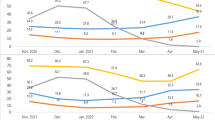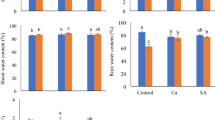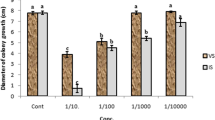Abstract
Root rot and head blight caused by soil-borne fungi are prevalent diseases endanger the global food security. The purpose of this study is to provide insight into the interaction of Fusarium graminearum with two weed extracts, concentrating on growth rate, physiological responses, molecular changes in wheat seedlings and yield parameters. In a pot experiment, wheat grains pre-soaked for 12 h either in distilled water or 25% aqueous weed extracts (purslane or chard) were germinated either in free or F. graminearum pre-inoculated sandy soil. The results revealed that F. graminearum inoculation resulted in reduced growth rate and chlorophyll content in wheat seedlings. However, following the fungal invasion, carotenoids, stress markers (EL, MDA, C = O, OH˙ and H2O2), non-enzymatic antioxidants (ascorbate and flavonoids), osmoregulators (GB, proline and free amino acids), antioxidant enzymes activity (CAT, POX, SOD and PPO) and the expression of some stress-induced genes (CAT, GR and PR4) were substantially increased. Nevertheless, priming of wheat grains with purslane or chard extracts resulted in enhanced growth rate, balanced chlorophyll content, decreased stress symptoms, restoration of the normal level of osmoregulators and antioxidant enzymes activity, as well as down-regulation of stress-induced genes in F. graminearum-infected wheat seedlings, besides improving yield characteristics. However, PR2 gene expression was not affected by either fungal infection or weed priming. In conclusion, natural weed extracts as supplement to chemical antifungals, can be safely employed to increase the growth rate and reconfigure the pathophysiological status of wheat seedlings by reducing the detrimental effects of F. graminearum infection.








Similar content being viewed by others
References
Abdel-Hafez SI, Ismail MA, Hussein NA, Abdel-Hameed NA (2009) The diversity of Fusarium species in Egyptian soils, with 3 new record species. Assiut Univ J Bot 1:129–147
Adandonon A, Aveling TA, Labuschagne N, Tamo M (2006) Biocontrol agents in combination with Moringa oleifera extract for integrated control of Sclerotium-caused cowpea damping-off and stem rot. Eur J Plant Pathol 115:409–418
Akter N, Islam MR (2017) Heat stress effects and management in wheat: a review. Agron Sustain Dev 37:37–42
Alkhail AA (2005) Antifungal activity of some extracts against some plant pathogenic fungi. Pakistan J Biol Sci 8:413–417
Anthony KK, George DS, Baldev Singh HK, Fung SM, Santhirasegaram V, Razali Z, Somasundram C (2017) Reactive oxygen species activity and antioxidant properties of Fusarium infected bananas. J Phytopathol 165:213–222
Arora A, Byrem TM, Nair MG, Strasburg GM (2000) Modulation of liposomal membrane fluidity by flavonoids and isoflavonoids. Arch Biochem Biophys 373:102–109
Aucique-pérez CE, Eduardo P, Silva DM, Ribas W, Murilo F, Ávila F (2017) Photosynthesis impairments and excitation energy dissipation on wheat plants supplied with silicon and infected with Pyricularia oryzae. Plant Physiol Biochem 121:196–205
Baghbani F, Lotfi R, Moharramnejad S, Bandehagh A, Roostaei M, Rastogi A, Kalaji HM (2019) Impact of Fusarium verticillioides on chlorophyll fluorescence parameters of two maize lines. Eur J Plant Pathol 154:337–346
Bates LS, Waldren RP, Teare ID (1973) Rapid determination of free proline for water-stress studies. Plant Soil 39:205–207
Beyer WF, Fridovich I (1987) Assaying for superoxide dismutase activity: some large consequences of minor changes in conditions. Anal Biochem 161:559–566
Blackman LM, Hardham AR (2008) Regulation of catalase activity and gene expression during Phytophthora nicotianae development and infection of tobacco. Mol Plant Pathol 9:495–510
Bolkent Ş, Yanardaǧ R, Tabakoǧlu-Oǧuz A, Özsoy-Saçan Ö (2000) Effects of chard (Beta vulgaris L. var. cicla) extract on pancreatic B cells in streptozotocin-diabetic rats: a morphological and biochemical study. J Ethnopharmacol 73:251–259
Braun H-J, Atlin G, Payne T (2010) Multi-location testing as a tool to identify plant response to global climate change. In: Climate change and crop production. CABI Wallingford, UK. pp 115–138.
Buerstmayr H, Buerstmayr M, Schweiger W, Steiner B (2014) Breeding for resistance to head blight caused by Fusarium spp. in wheat. CAB Rev 9:1–13
Chang CC, Yang MH, Wen HM, Chern JC (2002) Estimation of total flavonoid content in propolis by two complementary colorimetric methods. J Food Drug Anal 10:178–182
Chen K, Arora R (2013) Priming memory invokes seed stress-tolerance. Environ Exp Bot 94:33–45
Conrath U, Pieterse CMJ, Mauch-Mani B (2002) Priming in plant–pathogen interactions. Trends Plant Sci 7:210–216
Du YK, Liu J, Li XM, Pan FF, Wen ZG, Zhang TC, Yang PL (2017) Flavonoids extract from Portulaca oleracea L. induce Staphylococcus aureus death by apoptosis-like pathway. Int J Food Prop 20:S534–S542
Durgawale TP, Khanwelkar CC, Durgawale PP (2018) Phytochemical analysis of Portulaca oleracea and Portulaca quadrifida extracts using gas chromatography-mass spectrometry. Asian J Pharm Clin Res 11:204–207
Faostat F (2016) Agriculture Organization of the United Nations Statistics Division. Econ Soc Dev Dep Rome, Italy. http//faostat3 fao.org/home/E. Accessed 31 Dec 2016.
Farooq M, Hussain M, Nawaz A, Lee DJ, Alghamdi SS, Siddique KHM (2017) Seed priming improves chilling tolerance in chickpea by modulating germination metabolism, trehalose accumulation and carbon assimilation. Plant Physiol Biochem 111:274–283
Gao ZJ, Han XH, Xiao XG (2009) Purification and characterisation of polyphenol oxidase from red Swiss chard (Beta vulgaris subspecies cicla) leaves. Food Chem 117:342–348
Gill SS, Anjum NA, Hasanuzzaman M, Gill R, Trivedi DK, Ahmad I, Pereira E, Tuteja N (2013) Glutathione and glutathione reductase: a boon in disguise for plant abiotic stress defense operations. Plant Physiol Biochem 70:204–212
Grieve CMM, Grattan SRR (1983) Rapid assay for determination of water soluble quaternary ammonium compounds. Plant Soil 70:303–307
Gu C, Pan S (2017) Extraction, purification and antibacterial activity of polysaccharides from purslane. In: 2017 6th International Conference on Energy, Environment and Sustainable Development (ICEESD 2017).
Halliwell B, Aeschbacht R, Loligert J, Aruoma OI (1995) The characterization of antioxidants. Food Chem Toxicol 33:601–617
Hayat S, Hayat Q, Alyemeni MN, Wani AS, Pichtel J, Ahmad A (2012) Role of proline under changing environments: a review. Plant Signal Behav 7:1456–1466
Heath R, Packer L (1968) Photoperoxidation in isolated chloroplasts. Arch Biochem Biophys 125:189–198
Humphreys J, Cooke BM, Storey T (1995) Effects of seed-borne Microdochium nivale on establishment and grain yield of winter-sown wheat. Plant Var Seeds 8:107–117
Jindali KK, Singh RN (1975) Phenolic content in male and female Carica papaya: a possible physiological marker for sex identification of vegetative seedlings. Physiol Plant 33:104–107
Kato M, Shimizu S (1987) Chlorophyll metabolism in higher plants. VII. Chlorophyll degradation in senescing tobacco leaves; phenolic-dependent peroxidative degradation. Can J Bot 65:729–735
Khan TA, Mazid M, Mohammad F (2011) Role of ascorbic acid against pathogenesis in plants. J Stress Physiol Biochem 7:222–234
Koike S, Subbarao K, Davis RM, Turini T (2003) Vegetable diseases caused by soilborne pathogens. UCANR Publications.
Kugler F, Stintzing C, Carle R (2004) Identification of betalains from petioles of differently colored swiss chard (Beta vulgaris L. ssp. cicla [L.] Alef. Cv. Bright Lights) by high-performance liquid chromatography-electrospray ionization mass spectrometry. J Agric Food Chem 52:2975–2981
Kumar KB, Khan PA (1982) Peroxidase and polyphenol oxidase in excised ragi (Eleusine corocana cv PR 202) leaves during senescence. Indian J Exp Biol 20:412–416
Kuźniak E, Urbanek H (2000) The involvement of hydrogen peroxide in plant responses to stresses. Acta Physiol Plant 22:195–203
Lazarovits G, Turnbull A, Johnston-Monje D (2014) Plant health management: biological control of plant pathogens. Elsevier, New York
Lee YYP, Takahashi T (1966) An improved colorimetric determination of amino acids with the use of ninhydrin. Anal Biochem 14:71–77
Leslie JF, Summerell BA (2008) The Fusarium laboratory manual. Wiley, New York
Liu L, Howe P, Zhou Y, Xu Z, Hocart C (2000) Fatty acids and β-carotene in Australian purslane (Portulaca oleracea) varieties. J Chromatogr 893:207–213
Livak KJ, Schmittgen TD (2001) Analysis of relative gene expression data using real-time quantitative PCR and the 2-ΔΔCT method. Methods 25:402–408
Masoodi MH, Ahmad B, Mir SR, Zargar BA, Tabasum N (2011) Portulaca oleracea L. a review. J Pharm Res 4:3044–3048
Matern U, Kneusel R (1988) Phenolic compounds in plant disease resistance. Phytoparasitica 16:153–170
McMullen M, Bergstrom G, De Wolf E, Dill-Macky R, Hershman D, Shaner G, Van Sanford D (2012) Fusarium head blight disease cycle, symptoms, and impact on grain yield and quality frequency and magnitude of epidemics since 1997. Plant Dis 96:1712–1728
Menghani E, Sharma SK (2012) Antimicrobial activity of Juniperus communis and Solanum xanthocarpum. Int J Pharm Sci Res 3:2815–2818
Metzner H, Rau H, Senger H, Sieprawska A, Filek M, Tobiasz A, Walas S, Dudek-Adamska D, Grygo-Szymanko E (1965) Trace elements’ uptake and antioxidant response to excess of manganese in in vitro cells of sensitive and tolerant wheat. Planta 65:186–194
Mielniczuk E, Skwaryło-Bednarz B (2020) Fusarium head blight, mycotoxins and strategies for their reduction. Agronomy 10:509–535
Mierziak J, Kostyn K, Kulma A (2014) Flavonoids as important molecules of plant interactions with the environment. Molecules 19:16240–16265
Mithofer A, Schulze B, Boland W (2004) Biotic and heavy metal stress response in plants: evidence for common signals. FEBS Lett 566:1–5
Mohammadi M, Kazemi H (2002) Changes in peroxidase and polyphenol oxidase activities in susceptible and resistant wheat heads inoculated with Fusarium graminearum and induced resistance. Plant Sci 162:491–498
Momin RA, Nair MG (2001) Mosquitocidal, nematicidal, and antifungal compounds from Apium graveolens L. seeds. J Agric Food Chem 49:142–145
Ninfali P, Angelino D (2013) Nutritional and functional potential of Beta vulgaris cicla and rubra. Fitoterapia 89:188–199
Obagwu J, Korsten L (2003) Control of citrus green and blue molds with garlic extracts. Eur J Plant Pathol 109:221–225
Oh KB, Chang IM, Hwang KJ, Mar W (2000) Detection of antifungal activity in Portulaca oleracea by a single-cell bioassay system. Phyther Res 14:329–332
Osborne LE, Stein JM (2007) Epidemiology of Fusarium head blight on small-grain cereals. Int J Food Microbiol 119:103–108
Oser BL (1979) Hawk’s physiological chemistry. McGraw-Hills, New York
Pokluda R, Kuben J (2002) Comparison of selected Swiss chard (Beta vulgaris ssp. cicla L.) varieties. Hortic Sci 29:114–118
Porter IJ, Merriman PR (1983) Effects of solarization of soil on nematode and fungal pathogens at two sites in Victoria. Soil Biol Biochem 15:39–44
Reznick AZ, Packer L (1994) Oxidative damage to proteins: spectrophotometric method for carbonyl assay. Methods in enzymology. Elsevier, New York, pp 357–363
Sairam RKR, Srivastava GC, Agarwal S, Meena RCR (2005) Differences in antioxidant activity in response to salinity stress in tolerant and susceptible wheat genotypes. Biol Plant 49:85–91
Saleha YM (2010) Gene expression and histopathology alterations during rat mammary carcinogenesis induced by 7, 12-dimethylbenz [a] anthracene and the protective role of neem (Azadirachta indica) leaf extract. J Am Sci 6:843–859
Salhi N, Mohammed Saghir SA, Terzi V, Brahmi I, Ghedairi N, Bissati S (2017) Antifungal activity of aqueous extracts of some dominant Algerian medicinal plants. Biomed Res Int 2017:1–6
Saremi H, Okhovvat SM, Ashrafi SJ (2011) Fusarium diseases as the main soil borne fungal pathogen on plants and their control management with soil solarization in Iran. Afr J Biotechnol 10:18391–18398
Serrano AR, Castillo JL, Novo JJ, Ocaña AF, Rodríguez MVG (2007) Chitinase and peroxidase activities in sunflower hypocotyls: effects of BTH and inoculation with Plasmopara halstedii. Biol Plant 51:149–152
Sharma A, Shahzad B, Kumar V, Kohli SK, Sidhu GPS, Bali AS, Handa N, Kapoor D, Bhardwaj R, Zheng B (2019) Phytohormones regulate accumulation of osmolytes under abiotic stress. Biomolecules 9:285
Sobhy S, Saad-Allah K, Abo-Kassem E, Hafez E, Sewelam N (2019) Seed priming in natural weed extracts represents a promising practice for alleviating lead stress toxicity. Egypt J Exp Biol 15:453–468
Sorahinobar M, Soltanloo H, Niknam V, Ebrahimzadeh H (2017) Physiological and molecular responses of resistant and susceptible wheat cultivars to Fusarium graminearum mycotoxin extract. Can J Plant Pathol 39:444–453
Stintzi A, Heitza T, Prasadb V, Kauffmanna S, Geoffroya P, Legranda M, Fritiga B (1993) Plant pathogenesis-related proteins and their role in defense against pathogens. Biochimie 75:687–706
Taheri P, Kakooee T (2017) Reactive oxygen species accumulation and homeostasis are involved in plant immunity to an opportunistic fungal pathogen. J Plant Physiol 216:152–163
Uddin K, Juraimi AS, Hossain S, Altaf M, Nahar U, Ali E, Rahman MM (2014) Purslane weed (Portulaca oleracea): a prospective plant source of nutrition, omega-3 fatty acid, and antioxidant attributes. Sci World J 2014:1–6
Velikova V, Yordanov I, Edreva A (2000) Oxidative stress and some antioxidant systems in acid rain-treated bean plants. Plant Sci 151:59–66
Wang M, Firrman J, Liu L, Yam K (2019) A review on flavonoid apigenin: dietary intake, ADME, antimicrobial effects, and interactions with human gut microbiota. Biomed Res Int 2019:1–18
Zhang P, Zhou MP, Zhang X, Huo Y, Ma HX (2013) Change of defensive-related enzyme in wheat crown rot seedlings infected by Fusarium graminearum. Cereal Res Commun 41:431–439
Funding
This research did not receive any specific grant from funding agencies in the public, commercial, or not-for-profit sectors.
Author information
Authors and Affiliations
Contributions
SS involved in conceptualization, methodology, software, data curation, original draft preparation, software and validation. EEMAK involved in conceptualization, visualization, supervision and reviewing. NS involved in conceptualization, visualization, supervision validation and reviewing. EH involved in conceptualization, visualization and investigation. DA involved in conceptualization and visualization. KS involved in conceptualization, visualization, methodology, investigation validation, software, original draft preparation, reviewing and editing.
Corresponding author
Ethics declarations
Conflict of interest
On behalf of all authors, the corresponding author states that there is no conflict of interest.
Additional information
Handling Editor: Ranjit Riar.
Publisher's Note
Springer Nature remains neutral with regard to jurisdictional claims in published maps and institutional affiliations.
Rights and permissions
About this article
Cite this article
Sobhy, S.E., Abo-Kassem, EE.M., Sewelam, N.A. et al. Pre-soaking in Weed Extracts is a Reasonable Approach to Mitigate Fusarium graminearum Infection in Wheat. J Plant Growth Regul 41, 2261–2278 (2022). https://doi.org/10.1007/s00344-021-10442-y
Received:
Accepted:
Published:
Issue Date:
DOI: https://doi.org/10.1007/s00344-021-10442-y




